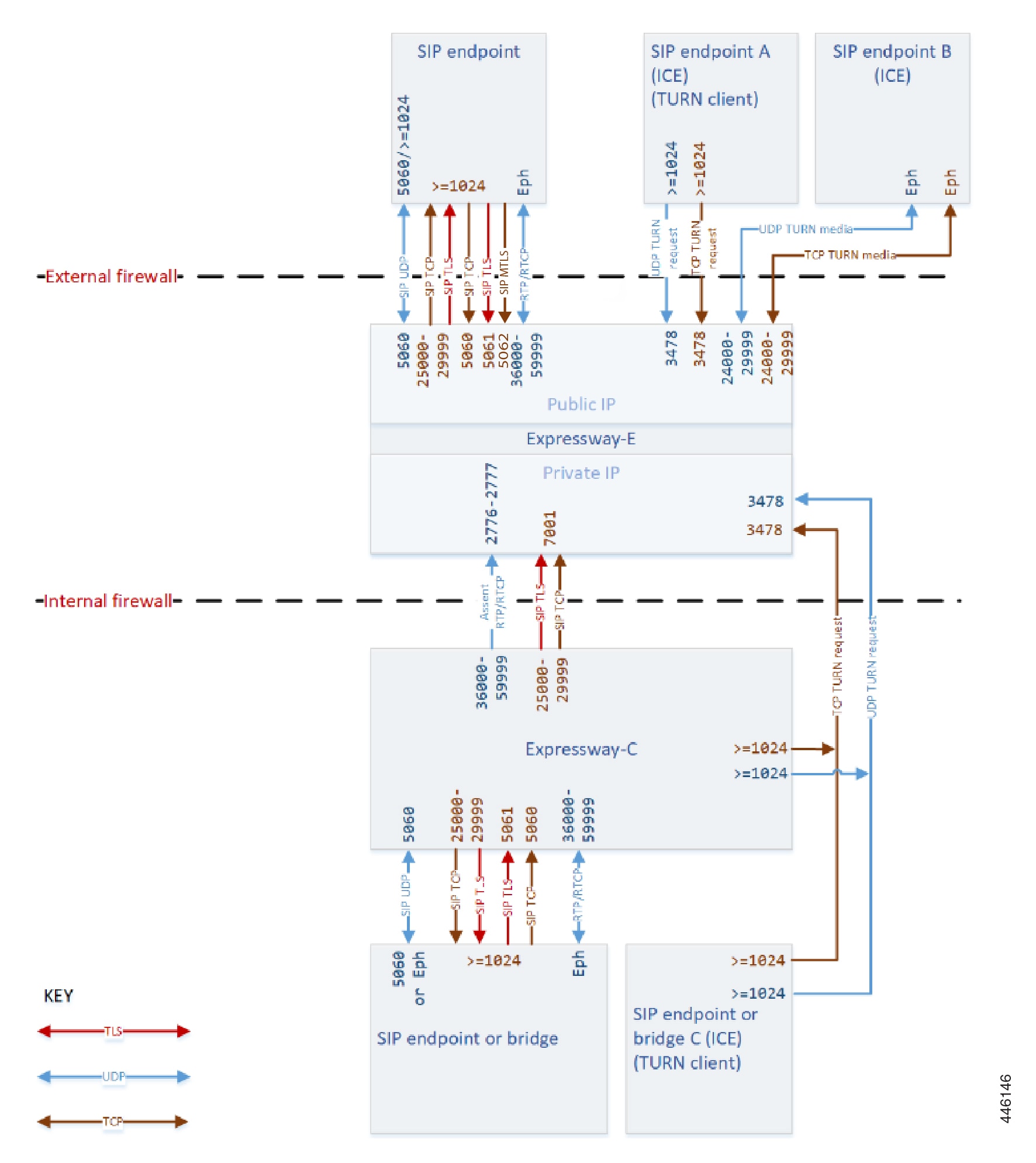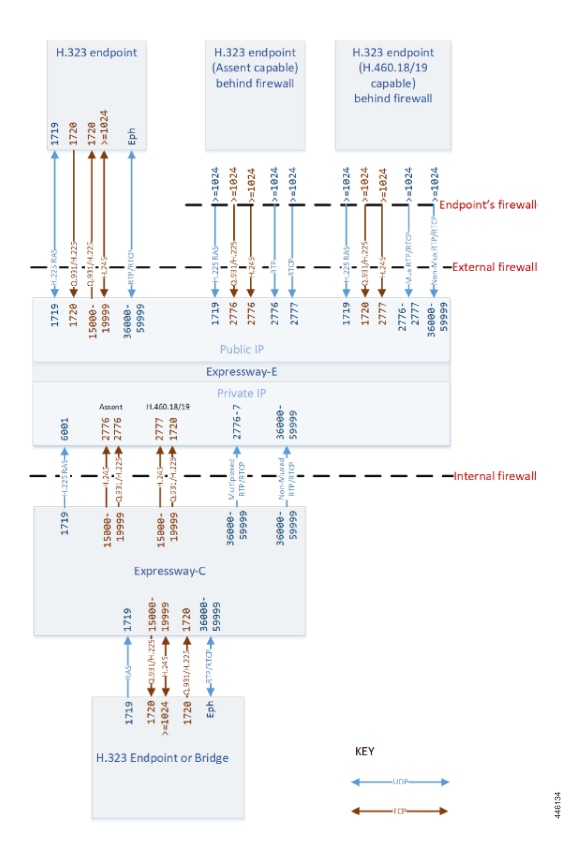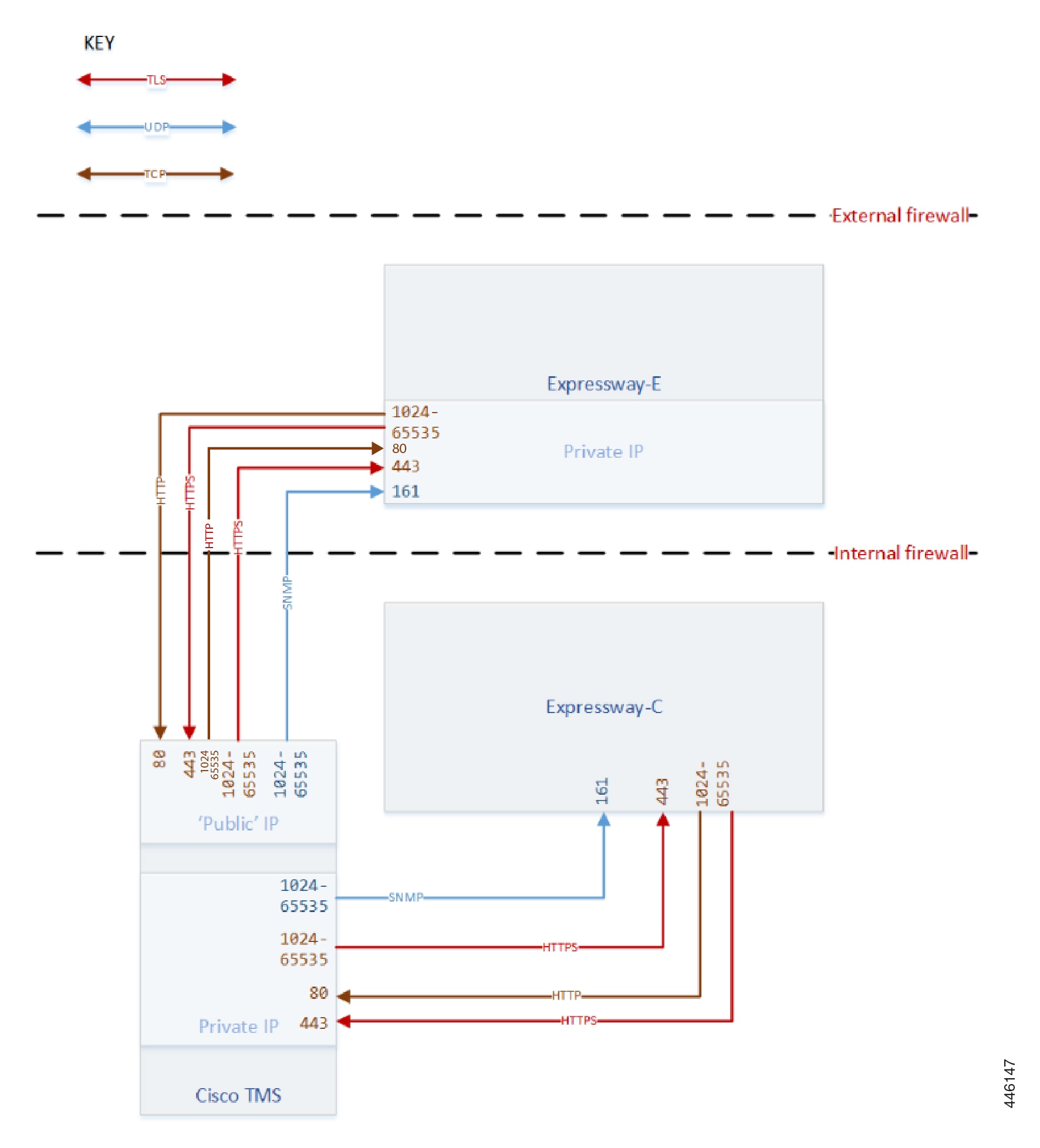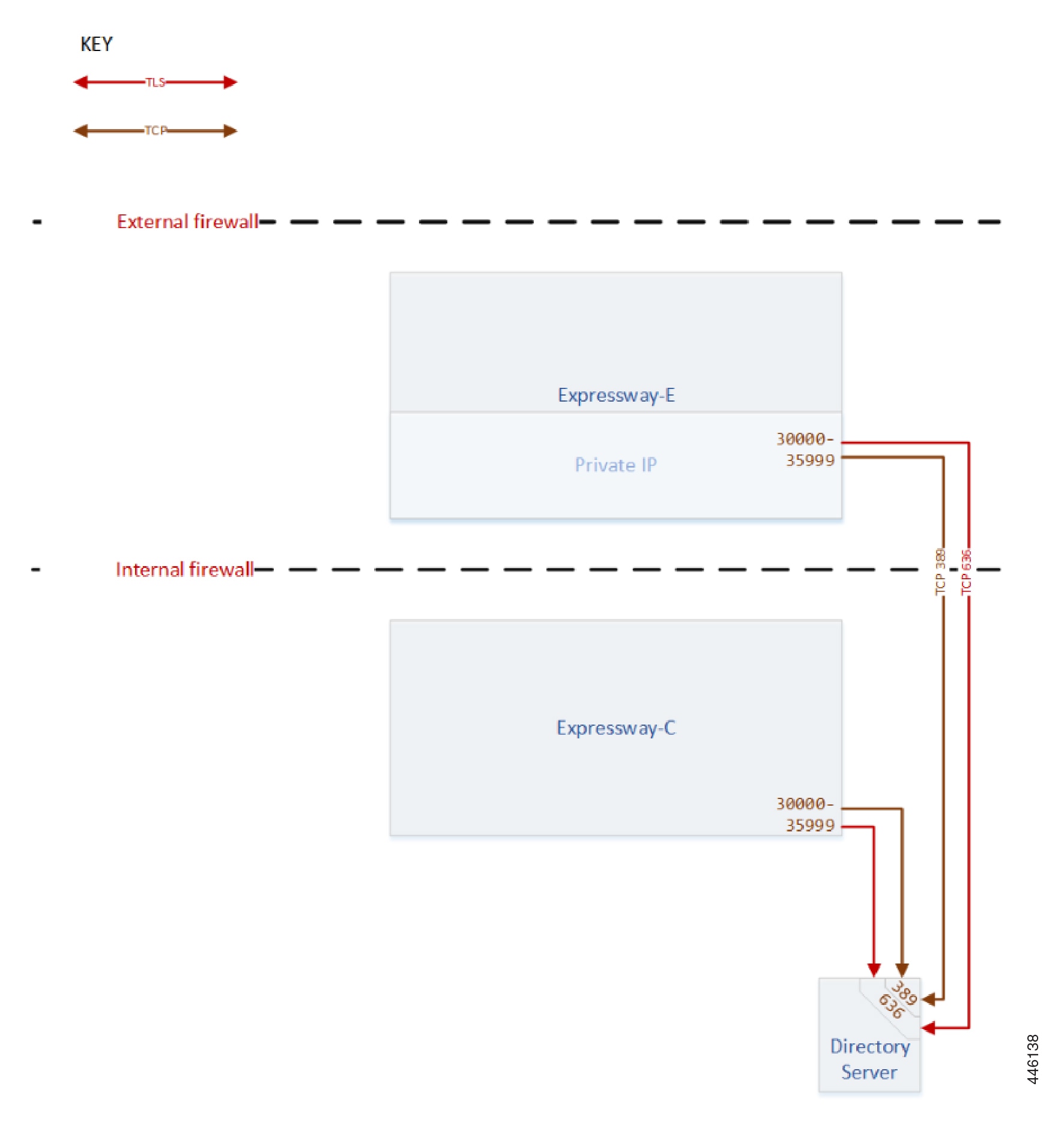SIP Calls

The documentation set for this product strives to use bias-free language. For the purposes of this documentation set, bias-free is defined as language that does not imply discrimination based on age, disability, gender, racial identity, ethnic identity, sexual orientation, socioeconomic status, and intersectionality. Exceptions may be present in the documentation due to language that is hardcoded in the user interfaces of the product software, language used based on RFP documentation, or language that is used by a referenced third-party product. Learn more about how Cisco is using Inclusive Language.

|
Purpose |
Src. IP |
Src. Ports |
Protocol |
Dest. IP |
Dest. Ports |
|---|---|---|---|---|---|
|
SIP signaling |
Expressway-C |
25000-29999 |
TCP or TLS |
Expressway-E |
7001 (for first traversal zone; 7002 for second etc.) |
|
SIP signaling |
Expressway-C |
5060 |
UDP |
SIP endpoint |
5060 (often, but could be different, >=1024) Port number defined by registration (if registered) or by DNS lookup |
|
SIP signaling |
Expressway-C |
25000-29999 |
TCP or TLS |
SIP endpoint |
>=1024 Port number defined by registration (if registered) or by DNS lookup |
|
SIP signaling |
Expressway-E |
25000-29999 |
TCP or TLS |
SIP endpoint (or its firewall) |
>=1024 Port number defined by registration (if registered) or by DNS lookup |
|
SIP signaling |
SIP endpoint (or its firewall) |
>=1024 |
UDP |
Expressway-E |
5060 SIP UDP disabled by default. Not recommended for internet facing connections. |
|
SIP signaling |
SIP endpoint (or its firewall) |
>=1024 |
TCP |
Expressway-E |
5060 SIP TCP disabled by default (X8.9.2 and later). |
|
SIP signaling |
SIP endpoint (or its firewall) |
>=1024 |
TLS |
Expressway-E |
5061 |
|
SIP signaling |
SIP endpoint (or its firewall) |
>=1024 |
MTLS |
Expressway-E |
5062 |
|
Assent RTP (traversed media) |
Expressway-C |
36000-59999 |
UDP |
Expressway-E |
2776 or 36000 (Small/Medium) 36000 - 36010 (even ports) (Large) |
|
Assent RTCP (traversed media) |
Expressway-C |
36000-59999 |
UDP |
Expressway-E |
2777 or 36001 (Small/Medium) 36001 - 36011 (odd ports) (Large) |
|
Assent RTP (traversed media) |
SIP endpoint (or its firewall) |
>=1024 Could be the firewall port where the media egressed, rather than an endpoint port |
UDP |
Expressway-E |
36000-59999 |
|
Assent RTCP (traversed media) |
SIP endpoint (or its firewall) |
>=1024 Could be translated by the firewall to port where the media egressed, rather than an endpoint port |
UDP |
Expressway-E |
36000-59999 |
|
Assent RTP (traversed media) |
Expressway-E |
36000-59999 |
UDP |
SIP endpoint (or its firewall) |
>=1024 Expressway waits until it receives media, then sends media to that source port (which could be the port where the media egressed the firewall, not an endpoint port) |
|
TURN control |
Any IP address† |
>=1024 (signaling port from endpoint or the firewall) |
UDP & TCP |
Expressway-E |
3478 (Small/Medium) 3478-3483 (Large) |
|
TURN control |
Expressway-C |
>=1024 |
UDP & TCP |
Expressway-E |
3478 (Small/Medium) 3478-3483 (Large) |
|
TURN media |
Expressway-E |
24000-29999 |
UDP & TCP |
Any IP address |
>=1024 |
|
TURN media |
Any IP address‡ |
>=1024 Port of relevant ICE candidate: host IP port, server reflexive port (outside firewall port), or TURN server port |
UDP & TCP |
Expressway-E |
24000-29999 |
† The request could be from any IP address, unknown to the TURN server. Assume for example, that endpoint A and endpoint C (TURN clients) can use the Expressway-E TURN server. The actual IP address from which the TURN server receives the request could be the endpoint's firewall egress address (NATed).
‡ The media could go to any of the candidate addresses. For example, before ICE negotiation the TURN server does not know which of endpoint B's candidate addresses will be the highest priority.

|
Purpose |
Src. IP |
Src. Ports |
Protocol |
Dest. IP |
Dest. Ports |
|---|---|---|---|---|---|
|
Initial RAS connection |
Registered endpoint in the Internet |
1719 |
UDP |
Expressway-E (public) |
1719 |
|
Initial RAS connection |
Expressway-E (public) |
1719 |
UDP |
Registered endpoint in the Internet |
1719 |
|
Initial RAS connection |
External address of firewall protecting off-premises endpoint |
>=1024 |
UDP |
Expressway-E (public) |
1719 |
|
Initial RAS connection |
Expressway-C |
1719 |
UDP |
Expressway-E (private) |
6001 (for first traversal zone, 6002 for second etc.) |
|
Q.931 / H.225 signaling |
Any (endpoint in the Internet) |
1720 |
TCP |
Expressway-E (public) |
1720 |
|
Q.931 / H.225 signaling |
External address of firewall protecting off-premises Assent endpoint |
>=1024 |
TCP |
Expressway-E (public) |
2776 |
|
Q.931 / H.225 signaling |
External address of firewall protecting off-premises H.460.18/19 endpoint |
>=1024 |
TCP |
Expressway-E (public) |
1720 |
|
Q.931 / H.225 signaling |
Expressway-E (public) |
15000-19999 |
TCP |
Any (endpoint in the Internet) |
1720 (endpoint signaling port, specified during registration. Could be another port >=1024) |
|
Q.931 / H.225 signaling |
Expressway-C |
15000-19999 |
TCP |
Expressway-E (private) |
2776 (Assent calls) |
|
Q.931 / H.225 signaling |
Expressway-C |
15000-19999 |
TCP |
Expressway-E (private) |
1720 (H.460.18 calls) |
|
H.245 |
Expressway-C |
15000-19999 |
TCP |
Expressway-E (private) |
2776 (Assent calls) |
|
H.245 |
Expressway-C |
15000-19999 |
TCP |
Expressway-E (private) |
2777 (H.460.18 calls) |
|
H.245 |
Any (endpoint in the Internet) |
>=1024 |
TCP |
Expressway-E (public) |
15000-19999 |
|
H.245 |
Expressway-E (public) |
15000-19999 |
TCP |
Any (endpoint in the Internet) |
>=1024 (endpoint H.245 signaling port) |
|
H.245 |
External address of firewall protecting off-premises Assent endpoint |
>=1024 |
TCP |
Expressway-E (public) |
2776 |
|
H.245 |
External address of firewall protecting off-premises H.460.18/19 endpoint |
>=1024 |
TCP |
Expressway-E (public) |
2777 |
|
RTP (multiplexed traversal media) |
Expressway-C |
36000-59998 (even ports) |
UDP |
Expressway-E (private) |
2776 (Small/Medium) or 36000-36010 (even ports) (Large) |
|
RTCP (multiplexed traversal media) |
Expressway-C |
36001-59999 (odd ports) |
UDP |
Expressway-E (private) |
2777 (Small/Medium) or 36001-36011 (odd ports) (Large) |
|
RTP (non-multiplexed traversal media) |
Expressway-C |
36000-59998 (even ports) |
UDP |
Expressway-E (private) |
36000-59998 (even ports) |
|
RTCP (non-multiplexed traversal media) |
Expressway-C |
36001-59999 (odd ports) |
UDP |
Expressway-E (private) |
36001-59999 (odd ports) |
|
RTP (non-multiplexed) |
Expressway-E (public) |
36000-59998 (even ports) |
UDP |
Any (endpoint in the Internet) |
>=1024 (endpoint media range) |
|
RTCP (non-multiplexed) |
Expressway-E (public) |
36001-59999 (odd ports) |
UDP |
Any (endpoint in the Internet) |
>=1024 (endpoint media range) |
|
RTP (non-multiplexed) |
Any (endpoint in the Internet) |
>=1024 (endpoint media range) |
UDP |
Expressway-E (public) |
36000-59998 (even ports) |
|
RTCP (non-multiplexed) |
Any (endpoint in the Internet) |
>=1024 (endpoint media range) |
UDP |
Expressway-E (public) |
36001-59999 (odd ports) |
|
RTP (multiplexed traversal media) |
External address of firewall protecting off-premises H.460 endpoint (multiplexed media) |
>=1024 |
UDP |
Expressway-E (public) |
2776 (Small/Medium) or 36000-36010 (even ports) (Large) |
|
RTCP (multiplexed traversal media) |
External address of firewall protecting off-premises H.460 endpoint (multiplexed media) |
>=1024 |
UDP |
Expressway-E (public) |
2777 (Small/Medium) or 36001-36011 (odd ports) (Large) |
|
RTP (multiplexed traversal media) |
External address of firewall protecting off-premises H.460 endpoint (non-multiplexed media) |
>=1024 |
UDP |
Expressway-E (public) |
36000-59998 (even ports) |
|
RTCP (multiplexed traversal media) |
External address of firewall protecting off-premises H.460 endpoint (non-multiplexed media) |
>=1024 |
UDP |
Expressway-E (public) |
36001-59999 (odd ports) |

Cisco TMS can have two IP addresses; for managing public systems, or managing systems on the LAN. On Cisco TMS, go to . You should use the TMS public address with the Expressway-E, and the default LAN address with the Expressway-C.
|
Purpose |
Src. IP |
Src. Ports |
Protocol |
Dest. IP |
Dest. Ports |
|---|---|---|---|---|---|
|
SNMP for discovery of Expressway-E |
Cisco TMS External IP |
1024-65535 |
UDP |
Expressway-E private |
161 |
|
SNMP for discovery of Expressway-C |
Cisco TMS |
1024-65535 |
UDP |
Expressway-C |
161 |
|
HTTP Management of Expressway-E |
Cisco TMS External IP |
1024-65535 |
TCP |
Expressway-E private IP |
80 |
|
HTTP Management of Expressway-C |
Cisco TMS |
1024-65535 |
TCP |
Expressway-E private IP |
80 |
|
HTTPS Management of Expressway-E |
Cisco TMS External IP |
1024-65535 |
TCP |
Expressway-E private |
443 |
|
HTTPS Management of Expressway-C |
Cisco TMS |
1024-65535 |
TCP |
Expressway-C |
443 |
|
Feedback events (HTTP) |
Expressway-E private |
1024-65535 |
TCP |
Cisco TMS External IP |
80 |
|
Feedback events (HTTP) |
Expressway-C |
1024-65535 |
TCP |
Cisco TMS |
80 |
|
Feedback events (HTTPS) |
Expressway-E private |
1024-65535 |
TCP |
Cisco TMS External IP |
443 |
|
Feedback events (HTTPS) |
Expressway-C |
1024-65535 |
TCP |
Cisco TMS |
443 |

You can choose to use an LDAP server to authenticate and authorize administrator or user logins. You would only need to allow the LDAP ports inbound from the Expressway-E in the rare case where you want a user to log in from outside the network and you also do not allow credentials to be stored on the Expressway.
|
Purpose |
Src. IP |
Src. Ports |
Protocol |
Dest. IP |
Dest. Ports |
|---|---|---|---|---|---|
|
Authentication requests from the Expressway-C |
Expressway-C |
1024-65535 |
TCP |
Directory Server |
389 |
|
Authentication requests from the Expressway-E |
Expressway-E private |
1024-65535 |
TCP |
Directory Server |
389 |
|
Encrypted authentication requests from the Expressway-C |
Expressway-C |
1024-65535 |
TLS |
Directory Server |
636 |
|
Encrypted authentication requests from the Expressway-E |
Expressway-E private |
1024-65535 |
TLS |
Directory Server |
636 |